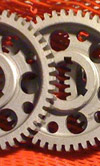Peening
 In the pages of Race Engine Technology and in these short web articles, there have been numerous mentions of the significant benefits of having residual compressive stresses present at the surface of a component. To recap, incorporating a method (or methods) of introducing residual compressive stress at a component's surface is, in general, likely to improve the endurance limit of a component loaded in bending or torsion. Given that there are very few components that are loaded in a purely axial sense, this rule of thumb can be usefully applied to many components, from con rods and crankshafts to castings.
In the pages of Race Engine Technology and in these short web articles, there have been numerous mentions of the significant benefits of having residual compressive stresses present at the surface of a component. To recap, incorporating a method (or methods) of introducing residual compressive stress at a component's surface is, in general, likely to improve the endurance limit of a component loaded in bending or torsion. Given that there are very few components that are loaded in a purely axial sense, this rule of thumb can be usefully applied to many components, from con rods and crankshafts to castings.
There are a number of ways of introducing such stresses during manufacture, including specialist machining methods, heat treatment and mechanical treatments. Mechanical treatments work the surface to produce compressive stress, and the main methods used are surface rolling and peening.
Peening is basically working the surface of a component by impact, and hammer peening of very large components is a visible example of what is happening on a very small scale in the shot-peening treatment. Essentially, the surface of a component is mechanically worked into the 'plastic' state through impact. The deformations are very small and the worked region is limited to a layer close to the surface.
Shot peening is a controlled version of shot blasting, where the size, form and hardness of the blasting media is closely controlled, as is the intensity and coverage of the component. It is popular for all manner of race engine components, being widely used in applications from reciprocating parts such as pistons and con rods, valvetrain components, gears and even on areas of castings that show a tendency to fail in fatigue.
The parameters of the shot-peening process are tailored to suit the type and hardness of material, and the particular geometry of the component. As we know from experience, fatigue failures are particularly apt to occur in tight machined radii, and this radius can be the limiting factor in the choice of media; there is no way for a spherical particle 0.5 mm in diameter to contact the surface of an inside corner with a 0.1 mm radius.

There are some more complex shot-peening treatments, called duplex treatments which peen the component, or certain areas of it, at two different intensities, in an attempt to have high stress at the surface and also treat the component to an increased depth below the surface. This is important in components such as gears, where the maximum stresses due to contact occur some way below the surface.
In addition to controlled shot peening, which can be carried out using 'guns' or 'lances' fed with compressed gas, or a machine where centrifugal action propels the shot towards the workpiece, there are various alternatives open to us. Other methods include needle peening, which is a miniature version of hammer peening using handheld equipment, and a rotary method where hard media attached to flexible wires are spun using a handheld tool. Neither of these methods can be considered to be as repeatable as controlled shot peening. Of course, shot blasting is an uncontrolled version of shot peening, and can be carried out using readily available equipment.
Laser peening is a new method that involves no mechanical working of the component with a tool. Compared to shot peening it is very clean, but is also very specialised and comparatively expensive. Widely used in modern aero engines, it is not thought to be widely used in motorsport.
Fig. 1 - Peening is very widely used in race engines to improve fatigue life. Gears are a popular application for duplex peening processes
Written by Wayne Ward